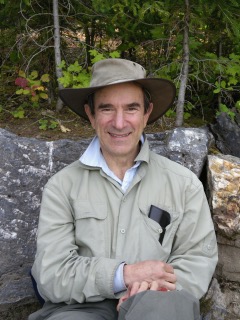
"I delight in creating kinetic sculpture machines which are novel, aesthetic, and unexpected, and which also can inspire, entertain, and demonstrate the power of engineering."
Seth Goldstein is a mechanical engineer who has been building instruments and machines for over 60 years. He was educated at MIT and spent most of his career practicing bioengineering at the National Institutes of Health where he was Chief of the Mechanical Engineering Section for almost two decades. Since retiring from the NIH in 2002, he has applied his skills to creating kinetic sculpture machines. Outside interests include hiking, flyfishing, wilderness camping, and tree conservation. He recently completed a 6-foot long model of the clipper ship Cutty Sark, which he has built from scratch.
His work has been featured in articles by: The New York Times and The Washington Post as well as in videos by CBS News.
Why Knot?
WHY KNOT? is a machine that continuously ties and unties a necktie.
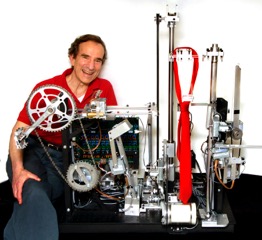
Computer control was provided by Randall Pursley.
WHY KNOT? received world-wide press coverage in videos made by Reuters (distributed to 80 countries), Globo TV (Latin America), and the Voice of America as well as articles in The Washington Post and Philadelphia Inquirer.
Cram Guy
CRAM GUY portrays a life-size student “grundge-bot” seated at a desk who is frantically cramming for an exam and then slows down, collapses into a dream state, is awakened by a loud gong, and starts the cramming cycle over again.
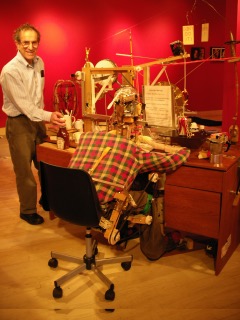
Computer control was provided by Randall Pursley. CRAM GUY was on display for 7 years at the American Visionary Arts Museum in Baltimore.
Ro-Bow
RO-BOW is a machine that plays a standard full-size violin. The horizontally orientated violin is rotated underneath a reciprocating violin bow while four mechanical fingers are moved to make contact, as appropriate, with the (highest) bowed string. Vibrato, pizzicato, legato, note-loudness modulation, and some other bowing effects are provided.
When music is played on an electronic keyboard, a MIDI file is generated which is edited, and then used as the input to the violin computer. This computer generates numbers to control the electronics, powering the various motors to perform the prescribed motions which enable the violin to play the same notes as were originally played on the keyboard.
When music is played on an electronic keyboard, a MIDI file is generated which is edited, and then used as the input to the violin computer. This computer generates numbers to control the electronics, powering the various motors to perform the prescribed motions which enable the violin to play the same notes as were originally played on the keyboard.
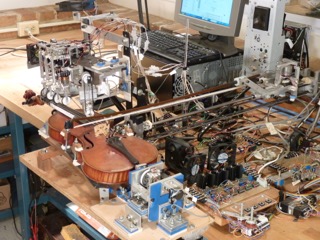
Computer control was provided by Randall Pursley.
RO-BOW received world-wide press coverage in a New York Times article, CBS, and a video made by the BBC.
My "Rube Goldberg" Exercise Bike

This all mechanical exercise bike fans me while I pedal, gives me a drink if I pedal fast enough for a long enough time, provides me cookie if I pedal long enough, and entertains me with a dog teasing a cat with a mouse. Five chains and 17 belts running off the main pedal runs it with the aid of a flyball governor, two high helix leadscrews, a bicycle pump, a flapper nozzle valve, a balloon, two rotating turntables and much more.
It was written up in The Washington Post
Whimcycle
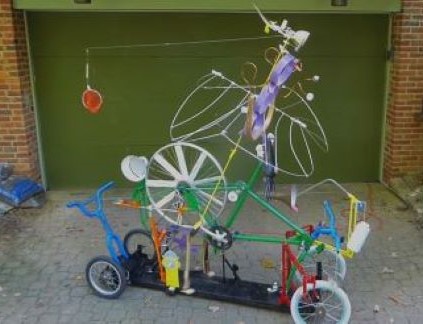
Whimcycle is a humorous moving conglomeration of sprockets, brackets, rods, chains, belts, springs, wheels, magnet wire, piano keys, kitchen utensils, desk lamps and more….- a fantasy sculpture made of recycled parts. It has one small electric motor (inside the grey paint can). It started with the idea of an uplifted bike with wings driven by the pedals, and then stuff was added until there wasn’t much room left. It’s whatever you want it to be…..
Model of Cutty Sark Clipper Ship
 |
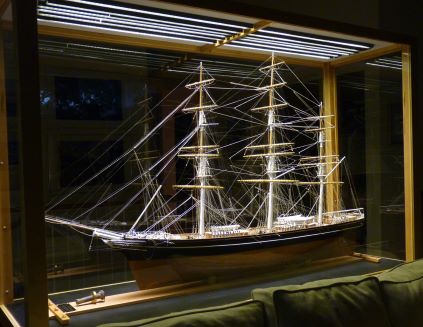 |
This model of the Cutty Sark Tea Clipper Ship is 6 feet long and 4 feet high. I started it in 1966 and finished it in 2018. The bronze bolt beneath the bowsprit is from the original ship which can be visited at the Royal Maritime Museum in Greenwich, UK. I hope to eventually place the model in a museum and welcome any inquiries towards that end.